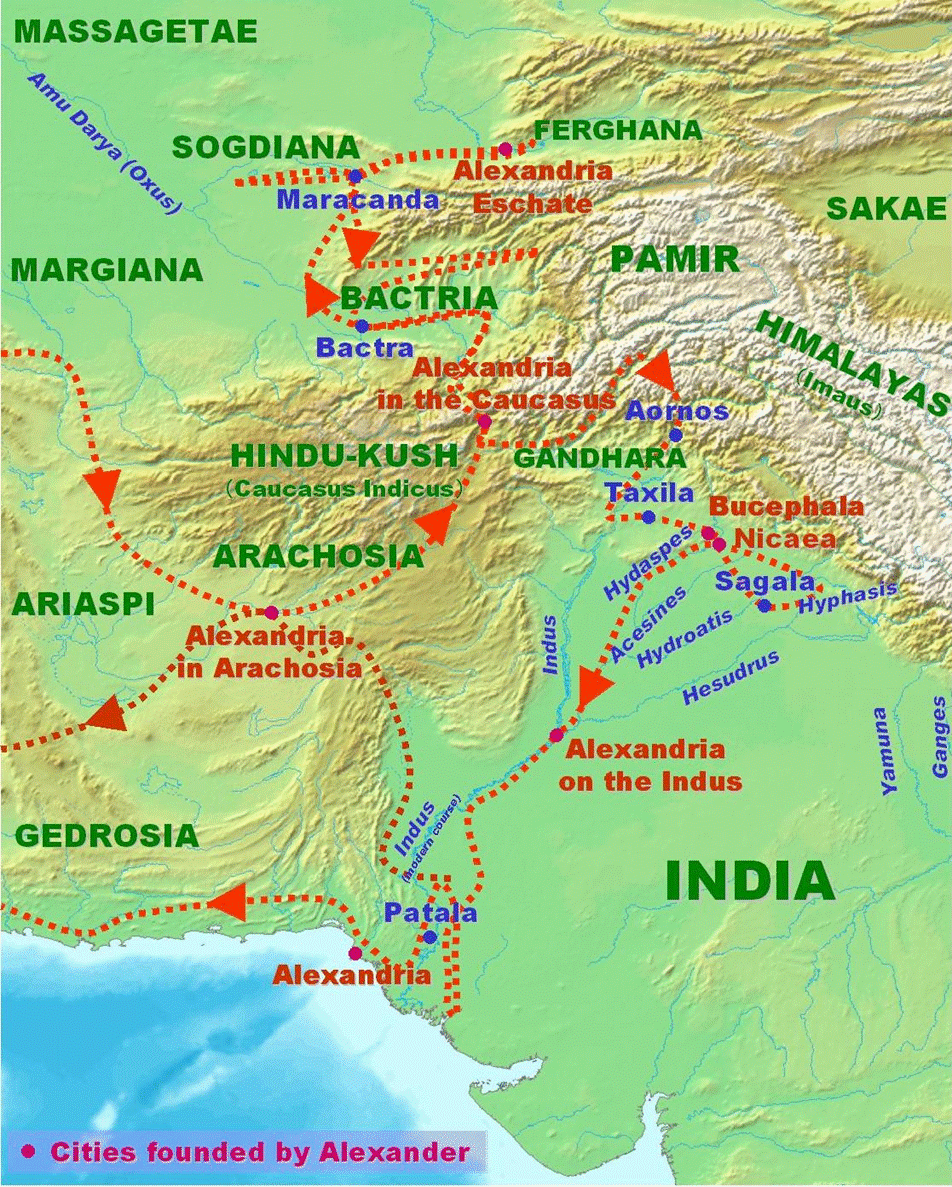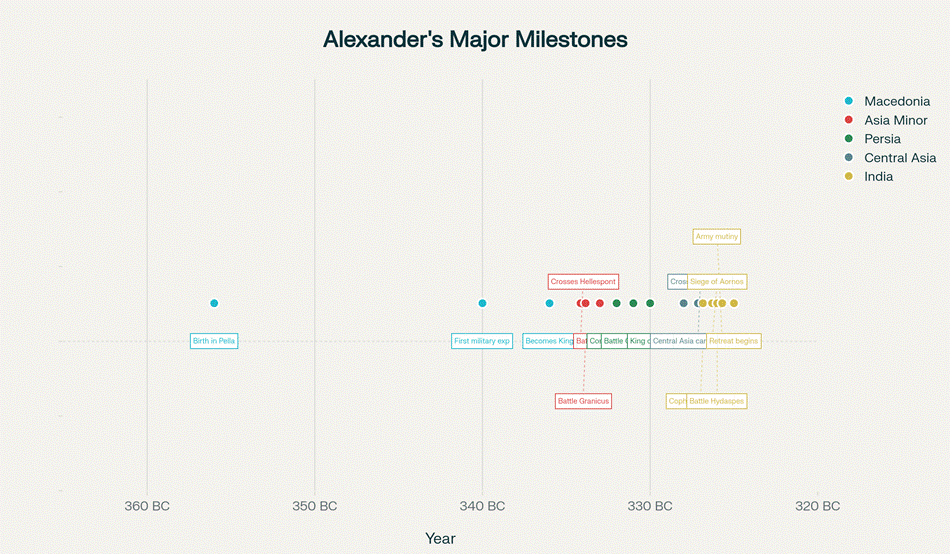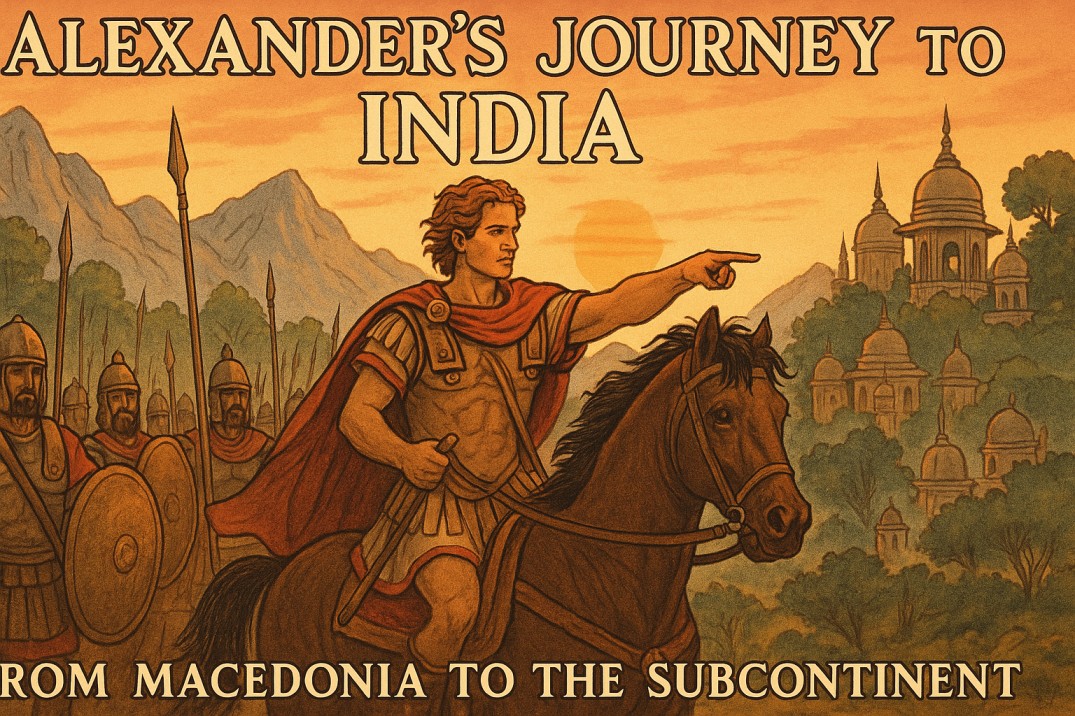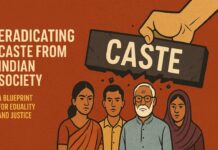Alexander the Great’s Arrival in the Indian Subcontinent: From Origins to the Eastern Campaign
Alexander III of Macedon’s journey from the northern Greek kingdom of Macedonia to the Indian subcontinent represents one of history’s most extraordinary military expeditions, fundamentally altering the political, cultural, and intellectual landscape of the ancient world. His arrival in India between 327-325 BC marked the culmination of a decade-long campaign that began with the assassination of his father, King Philip II, and evolved into an unprecedented eastward expansion that would bring Greek civilization into contact with ancient Indian kingdoms for the first time. This monumental journey not only established Alexander as one of history’s greatest military commanders but also initiated a period of Hellenistic influence that would profoundly impact art, philosophy, religion, and politics across vast regions of Asia for centuries to come.

Map showing Alexander the Great’s route and conquests from Persia through the Hindu Kush into the Indian subcontinent, including cities he founded.
The Macedonian Foundation: Early Life and Rise to Power
Origins in Pella and Royal Education
Alexander the Great was born on July 20, 356 BC, in Pella, the capital of the Kingdom of Macedon, to King Philip II and Queen Olympias of Epirus. From his earliest years, Alexander was groomed for leadership within a royal court that had transformed Macedonia from a peripheral Greek kingdom into a major Mediterranean power. His education under the philosopher Aristotle from ages 13 to 16 proved instrumental in shaping his worldview, instilling in him interests in philosophy, medicine, science, and literature that would later influence his approach to governing conquered territories.[1][2][3][4][5]

Ancient ruins of Pella, Macedonia, showing mosaic floors and columns at the birthplace of Alexander the Great.
The young prince demonstrated remarkable military acumen early in life. At age 16, while serving as regent during his father’s campaign against Byzantium, Alexander successfully defeated the Thracian Maedi tribe and founded his first city, Alexandroupolis. This early victory foreshadowed the military genius that would later enable him to conquer territories stretching from Egypt to India. His legendary taming of the unruly stallion Bucephalus at age 12 became symbolic of his ability to master seemingly impossible challenges.[2][6][4][7][8][9]
Ascension to the Throne and Consolidation of Power
When Philip II was assassinated in 336 BC, the twenty-year-old Alexander inherited not only the Macedonian throne but also his father’s ambitious plans to invade the Persian Empire. The transition was fraught with danger, as rival claimants to the throne and rebellious Greek city-states threatened to fragment the kingdom Philip had painstakingly unified. Alexander’s immediate response demonstrated the decisiveness that would characterize his entire reign—he swiftly eliminated internal threats, reasserted Macedonian hegemony over Greece by destroying the rebellious city of Thebes, and prepared for the eastern campaign that would define his legacy.[1][10][2][11][4][5]
The kingdom Alexander inherited was uniquely positioned for expansion. Philip II had revolutionized Macedonian military tactics, creating the famous phalanx formation with sarissa pikes and elite Companion Cavalry that would prove decisive in upcoming battles. More importantly, Macedonia controlled substantial resources and had established diplomatic relations that would facilitate Alexander’s later conquests.[10][11]
The Persian Campaign: Pathway to Asia
Crossing the Hellespont and Early Victories
In 334 BC, Alexander crossed the Hellespont into Asia Minor with an army of approximately 35,000 men, beginning what would become an eleven-year campaign of conquest. His first major engagement, the Battle of Granicus, established the tactical brilliance that would characterize his eastern campaigns. Victory at Granicus opened Asia Minor to Macedonian control and demonstrated Alexander’s personal courage in battle, as he led from the front and nearly lost his life in the initial charge.[1][10][11][12][13]
The subsequent conquest of Asia Minor proceeded with remarkable speed. Alexander’s victories at Miletus and Halicarnassus secured the Aegean coast, while his march through Gordium—where legend claims he cut the famous Gordian knot—symbolized his determination to rule Asia. Each victory brought not only territorial gains but also substantial wealth that funded further expansion and attracted additional allies to his cause.[10][14][12][13]
The Decisive Persian Campaigns
The Battle of Issus in 333 BC marked Alexander’s first direct confrontation with the Persian Great King Darius III. This victory was strategically crucial, as it not only defeated a massive Persian army but also resulted in the capture of Darius’s family, providing Alexander with valuable hostages and demonstrating Persian vulnerability. The psychological impact of Issus reverberated throughout the Persian Empire, encouraging local rulers to submit without resistance and undermining confidence in Darius’s leadership.[10][12][13]
Alexander’s conquest of Egypt in 332 BC further consolidated his position and provided both strategic advantages and religious legitimacy. The foundation of Alexandria at the mouth of the Nile would become one of the most important cities of the ancient world, serving as a center of learning and trade that facilitated cultural exchange between Greek and Egyptian civilizations. His consultation of the Oracle of Ammon, which declared him the son of the god Ammon-Ra, provided religious sanction for his rule that proved valuable in governing diverse populations.[15][16][10]
The climactic Battle of Gaugamela in 331 BC definitively ended Persian resistance and established Alexander as master of the Achaemenid Empire. This victory was achieved through tactical innovations that exploited weaknesses in the Persian battle line while maximizing the effectiveness of Macedonian cavalry and infantry coordination. With Darius’s subsequent murder by his own nobles in 330 BC, Alexander became undisputed ruler of the Persian Empire and adopted the title “King of Asia”.[13][10][15]
The Central Asian Interlude: Preparing for India
Campaigns in Bactria and Sogdiana
Between 329 and 327 BC, Alexander faced some of the most challenging campaigns of his career while subduing the provinces of Bactria and Sogdiana in what is now Afghanistan and Uzbekistan. These regions proved far more difficult to conquer than the organized Persian Empire, as local chieftains employed guerrilla tactics and exploited their knowledge of mountainous terrain. The campaigns required Alexander to adapt his military strategies to combat irregular forces and establish control over territories that had never been fully subdued by Persian authorities.[10][17]
The marriage of Alexander to Roxana, daughter of the Bactrian nobleman Oxyartes, in 327 BC represented both a personal alliance and a strategic political decision. This union helped secure the loyalty of Central Asian nobles and demonstrated Alexander’s willingness to integrate local elites into his emerging empire. The marriage also reflected his evolving vision of ruling through cultural synthesis rather than simple military domination.[7][17][18]
These Central Asian campaigns served as crucial preparation for the Indian expedition. Alexander established supply bases, recruited local troops familiar with regional conditions, and developed logistical networks that would prove essential for operations across the Hindu Kush. The experience of mountain warfare and dealing with tribal confederations provided valuable lessons that would be applied in the Indian subcontinent.[17][19]
Crossing the Hindu Kush: The Gateway to India
The crossing of the Hindu Kush mountains in 327 BC marked Alexander’s entry into the Indian sphere of influence. This formidable mountain barrier had historically separated Central Asian and Indian civilizations, and its traversal required careful planning and substantial resources. Alexander’s army crossed through multiple passes, with different units taking various routes to minimize logistical strain.[20][17][21][19]
The crossing was accomplished during late spring when snow had melted sufficiently to permit passage, but the expedition still faced significant challenges. The army had to transport supplies across treacherous terrain while maintaining combat readiness for potential resistance. Modern historians debate the exact route Alexander used, with suggestions ranging from the Khyber Pass to various other mountain passages, but the achievement itself demonstrates the logistical capabilities that enabled his subsequent Indian campaigns.[17][20]
The successful crossing brought Alexander’s forces to Alexandria-in-the-Caucasus (near modern Bagram), a city he had founded during an earlier expedition. This fortress served as a strategic base for operations in the Indian subcontinent and provided a secure line of communications back to the main body of the empire.[19][17]
The Indian Campaigns: Arrival and Conquest
The Cophen Campaign: Securing the Northwest
Upon entering the Indian subcontinent in 327 BC, Alexander initiated what historians term the Cophen Campaign, designed to secure the northwestern regions before advancing deeper into India. This campaign targeted the tribal confederations of the Aspasioi, Guraeans, and Assakenoi, who controlled strategic valleys in what is now Afghanistan and Pakistan. These tribes posed a significant threat to Alexander’s lines of communication and had to be subdued before any major advance could be attempted.[22][23][19]
The Cophen Campaign demonstrated Alexander’s strategic acumen in Indian conditions. Rather than attempting to advance immediately toward major Indian kingdoms, he methodically secured his rear areas and established the infrastructure necessary for sustained operations. The campaign involved numerous sieges of mountain fortresses, each requiring different tactical approaches adapted to local terrain and defensive capabilities.[23][19]
One of the most significant challenges faced during this period was the siege of mountain strongholds that had never been successfully captured. The tribal defenders employed defensive strategies that maximized their geographical advantages, forcing Alexander to develop new siege techniques and demonstrate the tactical flexibility that characterized his military leadership.[19][24]
The Siege of Aornos: The Unconquerable Fortress
The siege of Aornos in 327-326 BC represented Alexander’s final major operation before crossing the Indus River and engaging with the major Indian kingdoms. Aornos, identified with modern Pir-Sar in Pakistan, was considered impregnable due to its position on a steep mountain with sheer cliffs and abundant natural springs. Local legend claimed that even the mythical hero Heracles had failed to capture the fortress, making its conquest symbolically important for Alexander’s reputation.[25][19][26]
The siege showcased Alexander’s engineering capabilities and tactical innovation. Unable to assault the fortress directly, he captured a neighboring hill and used catapults to threaten the defenders’ positions. When this proved insufficient, Alexander ordered the construction of an earthwork mound to bridge a deep ravine separating his forces from the fortress walls. This massive engineering project required three days of intensive labor and demonstrated the discipline and determination of the Macedonian army.[19][26][25]
The successful capture of Aornos eliminated the last significant threat to Alexander’s supply lines and established his reputation throughout the Indian subcontinent. News of the victory spread rapidly among Indian rulers, influencing their decisions about whether to resist or submit to Macedonian forces. The psychological impact of conquering the “unconquerable” fortress proved as valuable as the strategic advantages gained.[21][25][19]
Alliance with Taxila: The Diplomatic Foundation
Alexander’s relationship with Ambhi (also known as Taxiles), the ruler of Taxila, exemplifies his sophisticated approach to Indian politics. Rather than relying solely on military conquest, Alexander actively sought local allies who could provide troops, supplies, and intelligence about regional conditions. Ambhi’s decision to ally with Alexander was motivated by longstanding hostility toward his neighbor Porus, who controlled territories between the Chenab and Jhelum rivers.[22][14][27][21][23]
The alliance with Taxila provided Alexander with substantial benefits beyond mere military support. Taxila was a major center of learning and trade, giving Alexander access to local knowledge about Indian geography, politics, and military capabilities. The city’s strategic location near the Indus River made it an ideal base for operations deeper into the Indian subcontinent.[27][28]
Ambhi’s submission also established a precedent for other Indian rulers considering their response to Macedonian expansion. Alexander’s generous treatment of cooperative local leaders—including substantial gifts of gold, horses, and luxury goods—demonstrated the benefits of alliance while the fate of resistant strongholds showed the consequences of opposition. This careful balance of incentives and threats proved crucial for maintaining control over conquered territories with limited manpower.[14]
The Battle of Hydaspes: The Decisive Engagement
Strategic Situation and Opposing Forces
The Battle of Hydaspes in 326 BC represented the culmination of Alexander’s Indian campaign and his most challenging military engagement in the subcontinent. King Porus (possibly Paurava) controlled the region between the Hydaspes (Jhelum) and Acesines (Chenab) rivers and commanded a formidable army that included the largest concentration of war elephants Alexander had ever faced.[29][22][30][31][23]
The opposing forces were relatively evenly matched in terms of total numbers, but their composition differed significantly. Alexander commanded approximately 40,000 infantry and 5,000-7,000 cavalry, supplemented by allied Indian troops under Ambhi. Porus fielded an estimated 20,000-50,000 infantry, 2,000-4,000 cavalry, 1,000 chariots, and 85-200 war elephants, depending on various historical accounts. The presence of war elephants posed a particular challenge, as Macedonian horses were terrified by these unfamiliar animals.[31][23][29]
The strategic situation was complicated by the Hydaspes River itself, which was swollen by monsoon rains and presented a formidable obstacle to any crossing attempt. Both armies encamped on opposite banks, with Porus shadowing Alexander’s movements to prevent any crossing attempt. This standoff continued for several days while Alexander searched for a suitable crossing point and developed his battle plan.[30][23][29][31]
Alexander’s Tactical Brilliance
The Battle of Hydaspes showcased Alexander’s tactical genius through his innovative approach to river crossing and battlefield coordination. Rather than attempting a direct assault across the river, Alexander divided his forces and executed a complex deception operation. While his general Craterus maintained the main camp and created the impression of preparing for a frontal crossing, Alexander led a select force 27 kilometers upstream to ford the river at night during a thunderstorm.[29][30][31][23]
This flanking maneuver caught Porus’s army off-guard and forced them to divide their forces. When Porus realized Alexander’s strategy, he sent his son with a cavalry force to oppose the crossing, but this detachment was defeated with heavy losses, including the death of Porus’s son. The main battle that followed demonstrated Alexander’s ability to adapt his tactics to unfamiliar conditions and enemy capabilities.[31][32]
The battle formation adopted by both sides reflected their respective strengths and strategic objectives. Porus placed his war elephants at the front of his line, with infantry formations between them and cavalry on the flanks. Alexander countered by placing his phalanx in the center while personally leading the right-wing cavalry charge and deploying his general Coenus with cavalry to outflank the Indian position.[30][31]
Outcome and Consequences
Alexander’s victory at Hydaspes was achieved at considerable cost, making it possibly the most expensive engagement of his entire career. The Macedonian army suffered heavy casualties in overcoming the Indian resistance, particularly from the war elephants that caused significant damage before being neutralized. However, the tactical lessons learned from this battle influenced subsequent military developments throughout the Hellenistic world.[29][31][33]
The aftermath of Hydaspes demonstrated Alexander’s political sophistication in dealing with defeated enemies. Impressed by Porus’s courage and leadership during the battle, Alexander not only spared his life but reinstated him as a satrap, effectively making him a regional governor under Macedonian authority. This decision reflected Alexander’s evolving approach to imperial administration, which increasingly relied on co-opting local elites rather than replacing them entirely.[30][33][29]
The victory had broader implications for Alexander’s Indian campaign and his imperial ambitions. Control of the Punjab region opened possibilities for further eastward expansion toward the Ganges River and the wealthy kingdoms of Magadha. However, it also marked the beginning of serious resistance within Alexander’s own army, as the costly nature of Indian warfare and the prospect of facing even larger armies began to undermine morale.[33][16]
The Limits of Conquest: Mutiny and Retreat
The Army’s Refusal at Hyphasis
Alexander’s advance eastward from the Hydaspes brought his army to the Hyphasis River (modern Beas) in 326 BC, where they encountered the most serious challenge to his leadership: a mutiny by his own troops. The soldiers’ refusal to advance further represented the culmination of years of continuous campaigning and growing concerns about the nature and objectives of their expedition. Reports of the massive armies of the Nanda Empire, with their 80,000 cavalry, 200,000 infantry, and 6,000 war elephants, convinced the Macedonians that they faced impossible odds.[10][16]
The mutiny was led by Alexander’s general Coenus, who articulated the army’s collective exhaustion and desire to return home. After eight years of continuous campaigning across thousands of miles, the soldiers longed to see their families and enjoy the wealth they had accumulated. The plea resonated with the entire army, forcing Alexander to confront the reality that even his legendary leadership had limits.[16]
Alexander’s response to the mutiny revealed both his emotional attachment to further conquest and his ultimate pragmatism as a leader. Initially, he attempted to persuade his troops through speeches emphasizing the glory of further conquests and the strategic advantages of controlling the entire Indian subcontinent. When these arguments failed to convince the army, Alexander withdrew to his tent for three days, hoping that isolation would change their minds.[16]
The Decision to Return
The army’s continued resistance ultimately forced Alexander to accept their decision and begin the return journey. This retreat marked the eastern limit of Alexander’s conquests and represented one of the few times in his career when his strategic objectives were constrained by factors beyond his military capabilities. The decision to turn back had profound implications for both the immediate expedition and the long-term development of his empire.[16]
Before beginning the retreat, Alexander established several foundations to commemorate his achievements and maintain a presence in the region. He founded Alexandria Nicaea (Victory) near the site of the Hydaspes battle and Alexandria Bucephalus on the opposite bank in honor of his beloved horse, who had died shortly after the battle. These cities served both as monuments to his conquests and as strategic outposts for potential future expansion.[32][34][9][16]
The death of Bucephalus during the Indian campaign held deep symbolic significance for Alexander and his army. The horse had carried Alexander through every major battle of his career and represented the connection between his Macedonian origins and his Asian conquests. Alexander’s grief at the loss and his decision to found a city in Bucephalus’s honor demonstrated the personal costs of the extended campaign.[34][8][9]
Cultural Impact and Historical Legacy
Hellenistic Influence in India
Alexander’s brief presence in the Indian subcontinent initiated a period of cultural exchange that profoundly influenced art, religion, and intellectual development across the region. The establishment of Greek settlements and the appointment of local rulers as satraps created networks for ongoing cultural interaction that persisted long after Alexander’s departure. These connections facilitated the emergence of Greco-Buddhist art and architecture, particularly in the Gandhara region, which blended Hellenistic artistic traditions with Buddhist religious themes.[35][18][36]
The impact of Greek artistic techniques on Buddhist iconography proved particularly significant and enduring. Greek artisans introduced realistic human representation and classical sculptural techniques to Buddhist art, leading to the first depictions of the Buddha in human form rather than symbolic representations. This artistic synthesis influenced Buddhist art throughout South and Southeast Asia for centuries, demonstrating the lasting impact of cultural exchange initiated during Alexander’s campaigns.[36][35]
The intellectual exchange between Greek and Indian traditions also produced important philosophical and scientific developments. Greek scholars who remained in India after Alexander’s departure contributed to advances in astronomy, mathematics, and medicine, while Indian philosophical concepts influenced Hellenistic thought. This bidirectional exchange enriched both civilizations and created synthetic intellectual traditions that persisted throughout the ancient period.[18]
Political and Military Consequences
Alexander’s Indian campaigns had immediate political consequences that shaped subsequent regional developments. The disruption of existing power structures created opportunities for new dynasties to emerge, most notably the Mauryan Empire under Chandragupta Maurya. Ancient sources suggest that Chandragupta may have encountered Alexander personally, and his later military strategies incorporated lessons learned from observing Macedonian tactics.[27][37]
The military innovations demonstrated during Alexander’s Indian campaigns influenced warfare throughout the ancient world. The successful integration of diverse troop types, adaptation to local conditions, and development of new siege techniques provided models that were studied and emulated by subsequent military commanders. The experience of fighting war elephants led to tactical developments that proved crucial in later conflicts throughout the Mediterranean world.[31]
The administrative approaches developed during the Indian campaigns also contributed to Hellenistic governmental practices. Alexander’s policy of appointing local rulers as satraps while maintaining Macedonian military oversight created precedents for imperial administration that were adopted throughout his empire and by successor kingdoms. This approach balanced the need for local knowledge and legitimacy with central control and strategic coordination.[33][18]

Timeline of Alexander the Great’s journey from Macedonia to the Indian subcontinent (356-325 BC)
Conclusion
Alexander the Great’s arrival in the Indian subcontinent represents the culmination of one of history’s most remarkable military and cultural expeditions. From his birth in the Macedonian capital of Pella in 356 BC to his crossing of the Hyphasis River in 326 BC, Alexander’s journey encompassed not merely geographical distance but a transformation from regional Greek king to master of a transcontinental empire that stretched from Egypt to India. His Indian campaigns, though ultimately limited by his army’s refusal to advance further east, established patterns of cultural exchange and political organization that influenced the development of civilization across vast regions of Asia for centuries to come.
The legacy of Alexander’s Indian expedition extends far beyond his military victories at Hydaspes and his diplomatic successes with rulers like Ambhi of Taxila. His arrival in India initiated a period of Hellenistic influence that transformed art, architecture, philosophy, and political organization throughout the subcontinent. The synthesis of Greek and Indian traditions that emerged from this encounter created new forms of cultural expression and intellectual inquiry that enriched both civilizations. The Greco-Buddhist artistic traditions of Gandhara, the administrative practices adopted by subsequent Indian dynasties, and the continuing exchange of scientific and philosophical ideas all demonstrate the enduring significance of Alexander’s brief but transformative presence in the Indian subcontinent.
Perhaps most importantly, Alexander’s Indian campaigns illustrate both the possibilities and limitations of ancient imperial expansion. His tactical brilliance at Hydaspes and diplomatic skill in managing diverse local populations demonstrated the heights of ancient military and political achievement. However, the army’s mutiny at Hyphasis revealed the human costs and practical constraints that ultimately determined the boundaries of even the most ambitious conquests. Alexander’s journey from Macedonia to India thus represents not only a remarkable military achievement but also a testament to the complex interactions between ambition, capability, and circumstance that shape the course of human history.
- https://www.confinity.com/legacies/alexander-the-great
- https://www.vedantu.com/biography/alexander-the-great
- https://www.britannica.com/biography/Alexander-the-Great
- https://testbook.com/ias-preparation/alexander-the-great
- https://www.bbc.co.uk/history/historic_figures/alexander_the_great.shtml
- https://byjus.com/free-ias-prep/alexander-the-great-356-323/
- https://whfpdubai.com/biography/alexander-great
- https://www.thecollector.com/bucephalus-alexander-horse/
- https://en.wikipedia.org/wiki/Bucephalus
- https://www.youtube.com/watch?v=F9ogNN4wMEs
- https://en.wikipedia.org/wiki/Wars_of_Alexander_the_Great
- https://subratachak.wordpress.com/2017/09/11/alexander/
- https://www.britannica.com/event/Battle-of-Gaugamela
- https://www.mygoldguide.in/alexander-great’s-1000-talents-gold
- https://www.britannica.com/summary/Alexander-the-Great-Timeline
- https://en.wikipedia.org/wiki/Alexander_the_Great
- https://makedonia-alexandros.blogspot.com/2017/08/alexander-crosses-hindu-kush-second-time.html
- https://rupkatha.com/V7/n2/03_Indo-Greek-Culture-Alexander.pdf
- https://en.wikipedia.org/wiki/Cophen_campaign
- https://testbook.com/question-answer/which-of-the-following-pass-was-used-by-alexander–67ac4d263f1dc6b397808b1e
- https://greekreporter.com/2024/12/20/alexander-the-great-india/
- https://byjus.com/free-ias-prep/battle-of-the-hydaspes-326-bc/
- https://www.thecollector.com/alexander-the-great-india-conquest-achaemenid-empire/
- https://military-history.fandom.com/wiki/Cophen_Campaign
- https://alexander-the-great.org/alexanders-campaign/siege-of-aornos
- https://www.britannica.com/event/Siege-of-Aornos
- https://en.wikipedia.org/wiki/Gandhara
- https://testbook.com/ias-preparation/battle-of-the-hydaspes-326-bc
- https://en.wikipedia.org/wiki/Battle_of_the_Hydaspes
- https://www.cheggindia.com/general-knowledge/battle-of-hydaspes/
- https://usiofindia.org/pdf/Oct-Dec 2016-133-148.pdf
- https://www.scribd.com/document/853352963/Indo-Greeks
- https://en.wikipedia.org/wiki/Indian_campaign_of_Alexander_the_Great
- https://www.historyskills.com/classroom/ancient-history/bucephalus/
- https://dhaaramagazine.in/2024/07/15/transformative-encounters-hellenistic-influence-in-buddhist-art-and-architecture/
- https://diplomatist.com/2022/11/03/ancient-india-and-ancient-greece-an-exploration-of-the-historical-connections/
- https://easymindmaps.com/history/alexander-in-india/
- https://silk-road.com/artl/alex.shtml/
- https://www.khanacademy.org/humanities/world-history/ancient-medieval/alexander-the-great/a/alexander-the-great
- https://ancienthistoryhub.com/the-king-of-conquest-alexander-the-great/
- https://www.britannica.com/event/Battle-of-the-Hydaspes
- https://www.youtube.com/watch?v=NxUXkhEoznQ
- http://savitri.in/blogs/light-of-supreme/alexanders-invasion-ambhi-was-not-a-traitor-by-arun-nigudkar
- https://www.reddit.com/r/geography/comments/1c4syyz/what_lasting_legacyeffects_did_the_greek_indian/
- https://prehistoric-britain.co.uk/alexander-the-great-sailed-into-india-where-no-rivers-exist-today
- https://scientiatutorials.in/echoes-of-antiquity-the-influence-of-greek-and-roman-culture-on-ancient-india/
- https://alexander-the-great.org/alexanders-campaign/alexanders-indian-campaign
- https://www.worldhistory.org/image/130/map-of-alexander-the-greats-conquests/
- https://www.thefridaytimes.com/22-Aug-2024/alexander-s-campaign-in-the-hills-of-the-gandhara-region
- https://www.colorado.edu/classics/2018/06/19/alexander-and-bucephalus
- https://www.newindianexpress.com/cities/bengaluru/2011/Aug/25/the-conqueror-who-loved-his-horse-284287.html
















